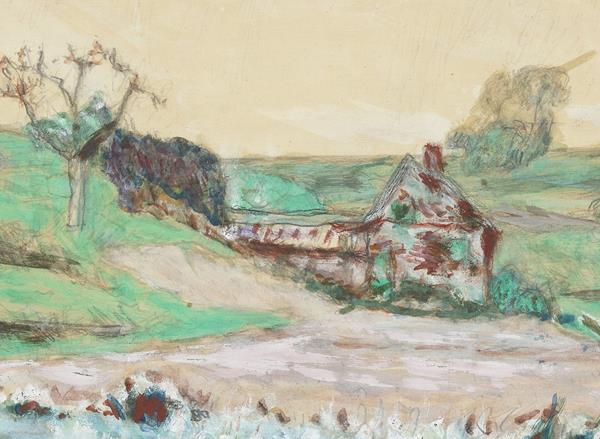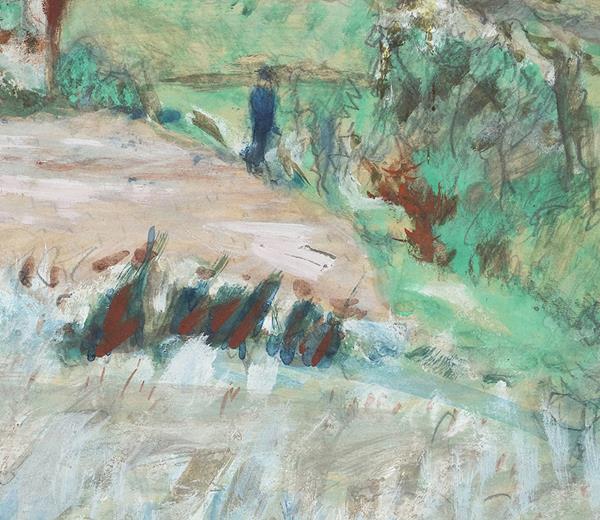"House in the Valley : A 19th Century Landscape Painted with a 20th Century Hand"
Pierre Bonnard

Jill Newhouse Gallery
4 East 81st Street New York, NY 10028
Telephone: (212) 249-9216 Fax: (212) 734-4098 e-mail:


from September 15, 2020




From 1910 to 1938, Bonnard lived in a house he named Ma Roulotte (My Gypsy Caravan) in the town of Vernon, close to Giverny. Throughout 1922, he recorded views of the sloping road leading to Vernon and the village roof tops, oddly abstracted by their positions among the hills.
Prior to 1910, Bonnard's style related closely to his graphic work and his work with the Nabis. His move to Vernon, however, took him away from an urban setting with its hard edges and dark interiors, and into nature’s forms and colors. A great admirer of Monet who was now nearly his neighbor, Bonnard's brush work began to loosen and his palette brighten. In the present work on paper, Bonnard recorded the brightness of greens and blues in the diffused and cloudy Normandy light with extraordinary layers of colors and variety of marks. Bonnard's distinctive pencil work retains its energy through layers of gouache and oil paints as he worked to catch the movement and freshness of the countryside. Up close, these marks are pure abstraction and one can see how the works of an abstract artist like Per Kirkeby are often compared to Bonnard's.
A closer look at the center of the work reveals the details of late fall. A tree holding on to its last leaves, the dusting of early snow, and smoke from the chimney. The house is one on the end of a row of three houses, with a high garden wall extending from the back.
Walking down the village road, the small figure is surrounded by the wild touches of color and energetic zig-zag of Bonnard's unique hand.
A further look at the lower left corner shows layers of media: pencil, gouache, and oil. They are built up, with the white pigment sitting on top of the rest, imitating snow on the field.
Prior to 1910, Bonnard's style related closely to his graphic work and his work with the Nabis. His move to Vernon, however, took him away from an urban setting with its hard edges and dark interiors, and into nature’s forms and colors. A great admirer of Monet who was now nearly his neighbor, Bonnard's brush work began to loosen and his palette brighten. In the present work on paper, Bonnard recorded the brightness of greens and blues in the diffused and cloudy Normandy light with extraordinary layers of colors and variety of marks. Bonnard's distinctive pencil work retains its energy through layers of gouache and oil paints as he worked to catch the movement and freshness of the countryside. Up close, these marks are pure abstraction and one can see how the works of an abstract artist like Per Kirkeby are often compared to Bonnard's.
A closer look at the center of the work reveals the details of late fall. A tree holding on to its last leaves, the dusting of early snow, and smoke from the chimney. The house is one on the end of a row of three houses, with a high garden wall extending from the back.
Walking down the village road, the small figure is surrounded by the wild touches of color and energetic zig-zag of Bonnard's unique hand.
A further look at the lower left corner shows layers of media: pencil, gouache, and oil. They are built up, with the white pigment sitting on top of the rest, imitating snow on the field.
 | Pierre Bonnard |
mpefm U.S.A. art press release
Opening hours :
by appointment only
Monday - Friday, 10 - 5:30
Please wear a mask
QR of this press release
in your phone, tablet








